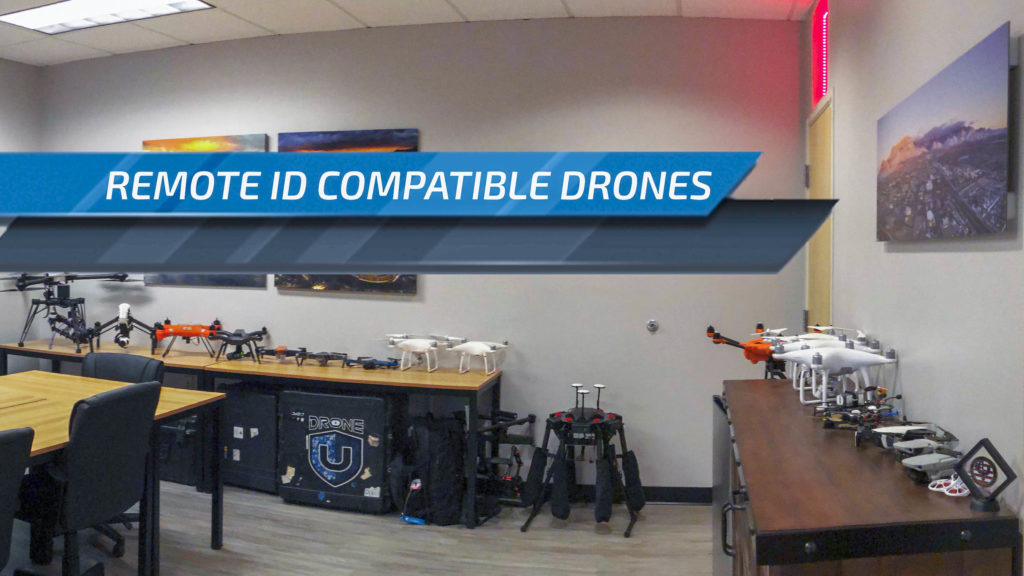The list of drones already compatible with Remote ID is long, and yet it won’t matter in 2023.
After posting our initial Remote ID rundown, it is clear that many drone pilots are still flustered regarding Remote Id. Albeit the anger and frustration may actually be caused by a misunderstanding of which aircraft work with Remote ID. Remote ID (standard) requires a Broadcast of information regarding the flight from the drone. The FAA did ensure that the public can see flight information, but not pilot information.
Unless we are misreading the Remote ID rules, most drones should comply with Broadcast Remote ID. How? because you will most likely not be flying those same drones in 2023….. Albeit it is impossible to know which drones actually comply with Remote ID or “RID.” While DJI developed a RID capable system into every drone, the FAA hasn’t released an approved RID protocol. Which means there is not a single drone on the market that is “RID capable.”
Most drones and even some FPV drones, already comply with the DJI based Remote ID system. That system was developed to showcase the FAA how a digital license plate system could work.
Albeit, the FAA has not yet released the protocol or approved module for remote ID communications.
So while most of the consumer drones that exist COULD be remote ID capable, the technical protocol hasn’t been released… Meaning that there are technically no drones that work with a system that hasn’t been published. Drone pilots and DJI would be stunned if the existing occusync system didn’t comply with this published protocol. DJI invested billions of dollars to have their drones be RID capable. Most of the drones we fly today already have this DJI “RID” system built in.
What drones already comply with Remote ID?
Since the FAA has not released the protocol for RID or an approved broadcast module, no drone is technically in compliance. As the compliance hasn’t been published.
It may not matter as your current drones might not even be airborne when Remote Id is officially implemented. Remember it will be 30 months from publishing before Remote ID operational rules take effect. Our DJI drones, when used often, have a shelf life of roughly 2 years. (Approx: depends on aircraft) DJI also tends to launch new aircraft in one and two year cycles. While most of the DJI drones are able to be seen across the aeroscope system and anti-drone tech, we believe that most consumer drones could be RID compliant with a firmware update.
We would imagine that there would be a plethora of NEW drones that would comply with RID, once implemented in 2023.
Drones that already comply with broadcast Remote ID
- DJI Phantom 4 Pro V2
- DJI Phantom 4 Pro
- DJI Phantom 4
- DJI Phantom 4 RTK
- DJI Phantom 4 Multispectral
- Mavic Pro
- Mavic 2 Pro
- Mavic 2 Zoom
- Mavic 2 Enterprise
- Mavic 2 Enterprise Dual
- Mavic 2 Enterprise Dual Advanced
- Mavic Air
- Mavic Air 2
- Mavic Mini
- Mini 2
- DJI Spark
- Inspire 1
- Inspire 2
- Inspire 2 Pro
- Matrice 200
- Matrice 210
- Matrice 300
Most existing drones should be able to comply with the FAA’s Remote ID… when the protocol is published. Since the FAA has not released how RID will actually work via protocol, its impossible to know which drones already use the protocol for RID.
Those DJI drones can be seen by a system called Aeroscope. DJI made it clear in 2017, that they wanted to provide a method of digital license plate, like what we see with RID. They also wanted to provide law enforcement with a method of viewing said system, thus Aeroscope.
It is much clearer, now, why DJI wanted to provide a method of RID that didn’t create burdens on operators. Can you imagine if the AMA would have taken RID so seriously?
We expect future drones made with the cube flight controller to be compatible as well. Albeit, we won’t know until the FAA publishes the compliance protocol for RID.
FPV drones currently compatible with Remote ID (Broadcast)
Frankly, most of the analog FPV drones will not comply with Remote ID.
Analog FPV drones do make up a majority (it seems) of FPV drones out in the world. Recently, digital FPV has become quite the hit with FPV pilots across the globe. DJI even launched the DJI air unit which will also power the new DJI FPV drone. The DJI air unit allowed pilots to fly FPV using a digital transmission. DJI’s air unit provided reliable control and video at significant distances… as long as you were flying line of site.
FPV pilots who use the DJI air unit to build an FPV drone might be happy. FPV drones that use DJI’s air unit are not currently Remote ID compatible. In the future, FPV flights might be seen by the neighbor. So now everyone will know when little Johnny is just flying his drone. You might only see with the DJI FPV drone, which would (we assume) have a GPS unit.
We just hope said neighbor doesn’t shoot down the drone.
Not because it is a federal crime, but because they realize the drone is not a threat.






Add Your Comment